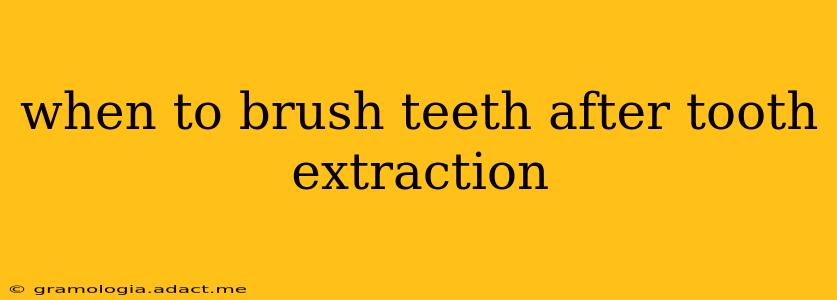Losing a tooth is a significant event, and knowing how to care for your mouth afterward is crucial for a smooth recovery. One of the most frequently asked questions revolves around brushing your teeth – a seemingly simple task that requires careful consideration after an extraction. This comprehensive guide will answer all your questions about when and how to brush your teeth following a tooth extraction.
How Soon Can I Brush My Teeth After Tooth Extraction?
This is arguably the most important question. The answer isn't a simple "24 hours" or "48 hours." It depends on the complexity of the extraction and your specific circumstances. Generally, you should wait at least 24 hours before brushing near the extraction site. This allows the blood clot to form, which is vital for healing and preventing dry socket (alveolar osteitis), a painful complication.
However, you can brush the rest of your teeth as normal. Good oral hygiene is essential even after an extraction, as it helps prevent infection in other areas of your mouth.
What Happens if I Brush Too Soon After Tooth Extraction?
Brushing too soon can dislodge the blood clot that's forming in the extraction socket. This clot protects the bone and nerves, and its removal can lead to:
- Dry Socket: This is a painful condition where the socket becomes exposed to air and bacteria. It's characterized by intense pain, a bad taste in the mouth, and sometimes a visible empty socket.
- Infection: Disrupting the healing process can increase the risk of infection.
How Should I Brush My Teeth After a Tooth Extraction?
Once the 24-hour waiting period (or your dentist's recommended time) has passed, you can carefully resume brushing around the extraction site. However, exercise caution:
- Gentle Brushing: Use a soft-bristled toothbrush and brush gently. Avoid scrubbing vigorously, especially near the extraction site.
- Avoid the Extraction Site Directly: For the first few days, try to avoid brushing directly on the extraction site. Instead, focus on cleaning the surrounding teeth.
- Rinse Gently: Gently rinse your mouth with saltwater (1/2 teaspoon of salt in 8 ounces of warm water) several times a day. This helps to keep the area clean and promotes healing.
When Can I Resume Normal Brushing?
The time it takes to resume normal brushing varies. It could be a few days, a week, or even longer, depending on the healing process. You should always follow your dentist's advice. Once the socket has begun to heal and the area feels less sensitive, you can gradually return to your regular brushing routine.
Can I Use Mouthwash After Tooth Extraction?
Similar to brushing, avoid using mouthwash directly on the extraction site for the first 24-48 hours. After that, you can use a mild, alcohol-free mouthwash to help keep the area clean. Always check with your dentist for recommendations.
What if I Experience Pain or Bleeding After Brushing?
If you experience any significant pain or bleeding after brushing, stop immediately and contact your dentist. It's crucial to monitor the healing process and address any complications promptly.
What About Flossing?
Flossing can be resumed after a few days, but again, avoid the extraction site directly. You can carefully floss around the area, ensuring you don't dislodge the blood clot.
Remember, proper post-extraction care is essential for a successful healing process. Always follow your dentist's instructions, and don't hesitate to contact them if you have any concerns. This information is for general guidance and should not replace professional dental advice.
